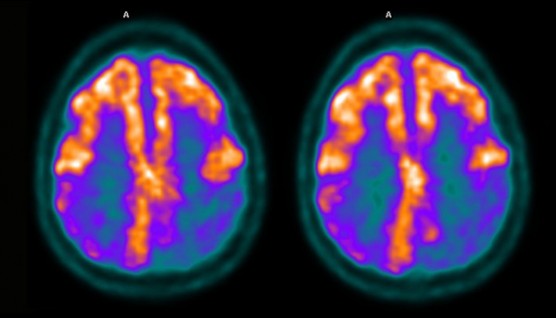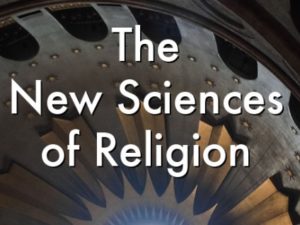NSoR 5: The Neurosciences of Religion

An excerpt from Chapter 5 of The New Sciences of Religion: Exploring Spirituality from the Outside In and Bottom Up (Palgrave Macmillan, 2010) Pages 103 – 106.
There are a number of problems inherent in these neuroscientific studies of religious and spiritual phenomena. First and foremost, religion is a complex neurocognitive experience that includes rituals, social groups, and a variety of other dimensions that are not easily replicated in a laboratory setting or isolated in individual human minds. Nor is it clear that all religious experiences are neurologically comparable. Talmudic studies, involving reading, analysis of text, and lively debate, may not be the least bit comparable to a Pentecostal experience of speaking in tongues. The contemplative practices of a Sri Lankan Buddhist may not be comparable to Hindu Bhakti devotions. Practicing Hatha yoga asanas in India may not be the same as Catholic self-flagellations at Good Friday observances in the Philippines. Listening to Bach cantatas at a Protestant church in Leipzig may not be the same as listening to Gamelan music played at a village temple in Bali. None of these phenomena is easily replicated in a laboratory. Science necessarily tries to simplify in order to pursue manageable research. Most of the neuroimaging studies focus on some kind of meditative or contemplative practice simply because it would be hard to study anything else in a hospital radiology department.
A fuller taxonomy of religious experience needs to be developed, detailed, and correlated with different brain states and cognitive theories of religion. Note that the list below does not necessarily indicate discrete experiences and can be combined in any number of ways in actual religious persons:
1. Interpretative experiences: understanding some event or circumstance to be religiously significant, as in serendipity, synchronicity, good or bad fortune;
2. Quasi-sensory experiences: auditory or visual experiences of the divine;
3. Revelatory experiences: receiving some insight about ultimate reality;
4. Regenerative experiences: a healing or catharsis in which problems or anxiety dissipate;
5. Ethical-moral experiences: grasped by moral obligation to act in the face of suffering or injustice;
6. Aesthetic experiences: an intense spiritual experience of beauty in nature or art, music, or ritual;
7. Intellectual experiences: an intense engagement in learning and problem-solving that takes on a spiritual dimension, for instance, in the moment of discovery or comprehension;
8. Ecstatic experiences: as in energetic devotional prayer, particularly in group context, perhaps not unlike a rock concert;
9. Numinous experiences: an encounter with Spirit that is Wholly-Other, being in the presence of God;
10. Oneness experiences: loss of distinction between self and world, nondual sense of unity with God and the universe.22
Another problem in the neuroscientific study of religious and spiritual phenomena is the tendency to draw ontological conclusions from these studies, typically either to validate or disprove some religious doctrine. This is philosophically bogus; one cannot prove or disprove the existence of God by studying someone’s brain. A neurological correlation does not equal causation or ultimate explanation. So what if Mohammad or Saint Paul had temporal lobe epilepsy? If God wants to use that mechanism to transmit His revelation, then so be it. Every thought we have, including scientific thoughts, also has measurable brain states. We can use a SPECT scan to study the brain of a physicist while he works on equations. We would learn lots of interesting things about the brain of a physicist, maybe generalizable to all physicists, perhaps also to all equations, but we would learn nothing about whether the physics is true.
Let us use a playful analogy and imagine what the neurosciences of sports might look like. There are a lot of different sports and we cannot study them all, so we are going to simplify by looking only at cricket. Still, cricket turns out to be really complicated, so we are going to need to simplify some more. We are not going to pay attention to the business of cricket, to the rules of the game, to the social practices and enculturation of cricket as a sport among the youth, to the fanatical fans in former British colonies, or to the complicated numerology of the sport. It is just too much; so we are going to focus on the neurological correlates of cricket. But whose cricket brain are we going to study, that of one of the boys from the Sunday pickup game in the village where I taught in Sri Lanka or, perhaps better, that of a professional player of cricket on the national team? We assume that a neuroscientific study of a cricket exemplar will be more revealing, so we select Sanath Jayasuriya of the Sri Lankan National Team to be our subject for a neuroimaging study of cricket, assuming that this is generalizable in some way to all cricket players, indeed to all sports. Before the big match, we outfit Jayasuriya with a remote-control IV, so that we can inject him with radioactive tracers in the midst of batting one of his cut-short shots during a big game. He swings the bat and hits a big one; unfortunately, now we have to stop the game, in order to whisk Jayasuriya away to the laboratory and put him into the SPECT scan. Don’t worry: the game can resume in half an hour because we will have finished the scan and can begin our analysis comparing his base-state brain with his cricket-state brain. No doubt we would learn something interesting about Jayasuriya’s brain, but we would be nowhere near understanding the phenomenon of cricket. We would not know whether his brain is the same as other cricket players’ brains or, for that matter, the brains of other athletes playing other sports — say, tennis, golf, or baseball. It might be that brain scans of the fans watching the match would reveal the same neurological correlates, given the phenomenon of mirror neurons, but we would need to test this.
From a strictly neuroreductionist point of view, we would not really know whether cricket was “real” or merely a “subjective” experience. It seems that the object of cricket is more concrete and objective than the objects of religion, but is that really so? You can take the neuroscientist to a cricket stadium and tell her, “Behold, here is cricket.” As an outsider, she probably has not acquired an appreciation of the game and will not understand the complicated rules. The object of cricket is to have fun, you might explain. Our neuroscientist would then have to ask, “What is fun?” Similarly, I could also take the neuroscientist to the monastery, the temple, the church, the synagogue, or the mosque, and say, “Behold, here is religion.” But she would still ask, “What is the object of all this activity? God, enlightenment, what’s that?” There is no “objective” reason, in either case, to divert so much time and energy, passion and skill, into either activity, whether cricket or religion. So, the neuroscientist postulates that maybe it has something to do with the brain states of cricket players and fans or the brain states of the religious believers, as the case may be.
Let’s push this reductio ad absurdum one step farther. What is the objective reality of the brains of a neuroscientist while they do neuroscience? The British geneticist J. B. S. Haldane (1892-1964) came to the same conclusion in thinking about the brains of scientists in general:
It seems to me immensely unlikely that mind is a mere by-product of matter. For if my mental processes are determined wholly by the motions of atoms in my brain, I have no reason to suppose that my beliefs are true. They may be sound chemically, but that does not make them sound logically. And hence I have no reason for supposing my brain to be composed of atoms. In order to escape from this necessity of sawing away the branch on which I am sitting, so to speak, I am compelled to believe that mind is not wholly conditioned by matter.23
As the Buddhist philosopher Alan Wallace points out in his book The Taboo of Subjectivity (2000), we still do not understand the mind:
Despite centuries of modern philosophical and scientific research into the nature of the mind, at present there is no technology that can detect the presence or absence of any kind of consciousness, for scientists do not even know what exactly is to be measured. Strictly speaking, at present there is no scientific evidence even for the existence of consciousness! All the direct evidence we have consists of nonscientific, first-person accounts of being conscious.24
Uncorroborated first-person accounts of anything do not count as adequate evidence in a court of law or in the sciences. These need to be correlated and corroborated by other evidence. The “I” cannot be trusted. Science leaves us with something like the Buddhist doctrine of anatman or no-self, a subtle and paradoxical doctrine in Buddhism. We have sawn off the branch on which we sit. Perhaps we need to rethink science and, with it, the neurosciences from the bottom up.
The Emergence of Mind
The problem is that science lacks an adequate metaphysics for incorporating both mind and matter. While this is an issue I will explore in more detail in chapter eight, it is useful to discuss some of these metaphysical and philosophical issues in our present context. Today, an informed metaphysics and philosophy of science needs to go beyond reductionism and materialism. We cannot really talk about science anymore without discussing emergent properties of phenomena and different levels of organization. The human brain is only one example of emergence in nature, but an extraordinary one to be sure. A single neuron may be beautiful to the discerning eye of a neuroscientist, but it is pretty stupid all by itself.
The concept of emergence says simply that the whole is more than the sum of its parts. We can learn a lot of interesting things about a brain cell by studying its parts and its chemistry. A quick perusal of the typically heavy undergraduate textbook on neurosciences should be adequate to demonstrate just how much we have learned in the last century through this kind of reductionist approach. That being said, the neuron itself could not be predicted or adequately described solely on basis of its constituent components. Nor can a brain be adequately understood by listing its parts. The human brain is an emergent phenomenon, both in its ontogeny — developmental biology — and its phylogeny — evolutionary biology.
Mind is also an emergent phenomenon. Mind cannot exist without a functional brain, but you could never predict consciousness on the basis of an exhaustive reductionistic description of the brain. Nor does mind-brain really do anything by itself. An isolated mind-brain would be a terrible waste. To reach its potential, a mind-brain requires an entire body, vocal chords, oppositional thumbs, tools, languages, families, societies, cultures, and nature. It is not just “soft” concepts like mind-from-brain that burst the reductionist dream of a mechanistic account of complex phenomena. There are ample examples of emergent properties throughout the sciences. From the surface tension of water in a glass to superfluidity and superconductivity in a physicist’s lab, the behavior of huge numbers of particles cannot be deduced from the properties of a single atom or molecule.
Notes
22. This is a compilation of different typologies of religious experience. See Ian Barbour, Religion in an Age of Science: The Gifford Lectures 1989-1991, vol. 1 (San Francisco: Harper, 1990), 36-38; Carolyn F. Davis, The Evidential Force of Religious Experience (New York: Oxford University Press, 1989), ch 2; and James Fowler, Stages of Faith: The Psychology of Human Development and the Quest for Meaning (San Francisco: Harper, 1981).
23. John B. S. Haldane, “When I Am Dead,” in Possible Worlds and Other Essays (London: Chatto and Windus, [1927] 1932).
24. B. Allan Wallace, The Taboo of Subjectivity: Towards a New Science of Consciousness (New York: Oxford University Press, 2000).







